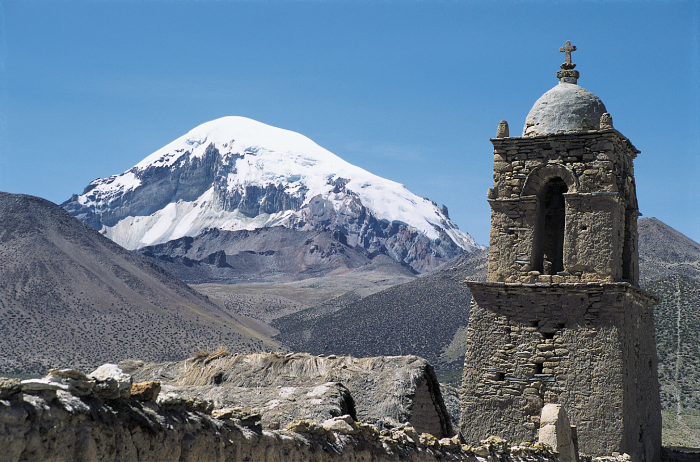



最近、熱帯地方の高地から採取された氷床コアは、過去の気候に関する長期にわたる詳細な記録を提供しています。これらの履歴には、地球規模の気候の変化や、人間の活動が最も多く行われている地域の環境の変化に関する情報が含まれています。
気候情報は、酸素同位体比、化学組成、塵の濃度など、コアの順に行われた地球化学測定の分析によって、氷床コアから再構築されます。オハイオ州立大学のロニー・トンプソン博士とそのチームは、1997 年 7 月にボリビアのアンデス山脈の氷冠の頂上で、岩盤まで 2 つの氷床コア (それぞれ 435 フィート) を掘削しました。マサチューセッツ大学 (UMass) の気候学者は、これらの科学者と協力して、氷冠の気候を記録し、その場所に積もる雪の地球化学的な変動の大気源をより深く理解しようとしています。
氷床コアの較正をサポートするため、ボリビア最高峰のサハマ (21,464 フィート、南緯 18 度 6 分、西経 68 度 53 分) の掘削現場付近と、サハマのほぼ 200 km 風上にあるネバド イリマニ (20,555 フィート、南緯 16 度 39 分、西経 67 度 47 分) で気象観測所が稼働しています。両観測所では、積雪量と融解量を 1 時間ごとに測定し、積雪温度やさまざまな気象変数も測定しています。これらのデータの分析は、観測所付近で実施される年間積雪量調査の結果や、NCEP (米国海洋大気庁の国立環境保護センター) の地球規模分析データと密接に結びついています。
これらのステーションの設計では、相反する目標のバランスを取る必要がありました。たとえば、正午には全球太陽放射照度が 1100 W m 2 を超える場合があり、温度センサーと湿度センサーの機械的な吸引が必要になります。十分な放射があればファンに連続電力を簡単に供給できますが、風圧を減らすためにシステム設計を 10 W のソーラー パネル 2 枚に制限しました。
その結果、ファンは 10 分のうち 1 分だけ作動します。両方のステーションは CR10X データロガーを中心に設計されています。データはデータロガーと SM716 ストレージ モジュールにオンサイトで保存され、両方のサイトで GOES テレメトリを使用してほぼリアルタイムで UMass にデータを配信します。Sajama ステーションは、ほとんどのセンサーを複製し、サーミスターと熱電対用の AM416 マルチプレクサを使用して CR10X の容量を最大限に活用しています。
観測所の設置と保守は冒険でした。高高度で稼働している気象観測所がこれほど少ないのは、私たちにとっては不思議ではありません。山頂に到着すると、まず風で固められた雪を6フィート掘り下げて観測所を探すことは考えられません。毎回の訪問で山頂で数晩過ごしますが、風が強すぎてテントがはためいて会話ができないこともよくあります。出発前に、衛星電話でマサチューセッツ大学に電話し、衛星テレメトリの安心できるチェックを行いました。
観測所の成果は実に目覚ましいものです。26 か月が経過した現在、ほとんどの変数に関するサハマ記録は 100% 完了しています。これは、1996 年から 1997 年の雨期に異常に大量の積雪 (13 フィート) があったにもかかわらずです。
これらの観測所から得られるデータには、今世紀最大のエルニーニョ現象の 1 つが含まれ、熱帯の氷床コアの記録に関する貴重な洞察が提供されています。
観測所に関する詳細と初年度の結果は、1998 年 9 月発行のアメリカ気象学会紀要および当協会の Web サイトwww.geo.umass.edu/climate/bolivia.htmlでご覧いただけます。NOAA の財政支援、Carlos Escobar のロジスティクス支援、および Campbell のエンジニアの献身に感謝いたします。
ケーススタディの概要
アプリケーション
高高度気象観測所は気候変動と氷床コアの研究を支援場所
ボリビア中西部使用製品
CR10X AM416 SM716寄稿者
Dr. Douglas Hardy, Geosciences Dept., University of Massachusetts参加団体
マサチューセッツ大学、オハイオ州立大学、NOAA計測項目
気候研究関連ウェブサイト
Sajama research projectPDFで見る